Abstract
Soccer is a complex sport, and balance appears to play a crucial role in the quality execution of technical skills, which are mostly performed while standing on one foot. Nevertheless, in younger ages, when learning still affects soccer performance, the effect of a balance-training program on the player’s balance and technical skills remains unexplored. This research examined the effect of a balance-training program (BTP) on balance and technical skills of adolescent soccer players. Τhe participating volunteers were thirty-two soccer players (12-13 years old with 3.84 ± 0.95 years of practice), randomly separated into two groups: an experimental (EXP, n1 = 17) and a control group (CON, n2 = 15). Both groups were evaluated in static and dynamic balance and in technical skills (dribbling, passing, juggling, and shooting with dominant and non-dominant legs) before (Pre-condition) and after the intervention (Post-condition) which was an eight-week BTP for the EXP group and a placebo-training program for the CON group. Α 2 by 2 (groups×condition) mixed analysis of variance (ANOVA) with repeated measures on the condition factor was used to assess possible differences between groups. A significant groups × condition interaction effect was found in dynamic balance (p = 0.008), static (p = 0.042), and shooting (p = 0.022) with dominant leg performance. The EXP group improved (p = 0.007) its static balance by 37.82% and also significantly improved its dynamic balance and shooting accuracy with dominant leg in Post condition by 24.98% (p = 0.006) and 83.84% (p = 0.006) respectively. No significant improvement of other variables was detected in the EXP group Post condition. Dynamic and static balance, and shooting with dominant leg skills can be improved in adolescent soccer players through a specialized 8-week BTP. Balance-training program may contribute to technical skill improvement in soccer training.
Key points.
Dynamic balance can be improved in adolescent soccer players through a specialized balance-training program.
Shooting skills with dominant leg can be improved in adolescent soccer players through a balance-training program of 8 weeks.
The specialized balance-training program of 8 weeks could contribute to technical skill improvement in soccer training.
Key words: Soccer technique, adolescence, dominant leg, steadiness, performance, proprioception
Introduction
Soccer is a complex sport, in which excellent performance depends on the interaction of a number of technical, tactical, physiological and mental features (Bangsbo, 1994; Zacharakis et al., 2021). Technical competence is also one of the most important factors in distinguishing players and determining their level (Lees and Nolan, 1998; Lees et al., 2010). However, many performance tasks such as vertical jumping, change of direction and technical skills such as passing, shooting, dribbling, receiving and controlling the ball are carried out while the player uses only one foot (Bekris et al., 2012), which means that balance may play an important role in athletic performance. Two review articles and one recent meta-analysis in children and adolescents (Hrysomallis, 2011; Kiers et al., 2013; Gebel et al., 2018) examined the relation between performance, sports expertise, and balance and concluded that improved balance performance is associated with sport performance (i.e., vertical jumping, sprinting, change-of-direction tasks). Therefore, one basic neuromuscular attachment skill which may also contribute to a successful performance in soccer is balance (Ricotti, 2011; Souglis et al., 2022).
Soccer players have high levels of balance, analogous to those of gymnastics athletes (Bressel et al., 2007), dancers (Gerbino et al., 2007) and basketball players (Bressel et al., 2007). However, significant differences of balance performance observed among soccer players of various technical levels suggest that balance performance varies depending on the competition level (Paillard et al., 2006; Butler et al., 2012; Ricotti et al., 2013). Along these lines an improvement in balance was presented after a 12-week program with 16-year-old soccer players (Gioftsidou et al., 2006). Nevertheless, in younger ages, when learning still affects soccer performance, the effect of a balance training program on the player’s balance remains largely unexplored, especially for players aged 12-13 years, which is a key age period for the development of certain skills, and performance at this age may be linked to success in adulthood (Roncesvalles et al., 2001; Mickle et al., 2011; Gebel et al., 2018).
Another issue that needs clarification is whether balance is linked to technical skills in 12-13-year-old soccer players. Few studies report any significant correlation between balance and technical skills (Bekris et al., 2012; Chew-Bullock et al., 2012; Cè et al., 2018). In particular, certain studies have shown a high correlation between balance with non-dominant leg and shot precision in non-soccer individuals (23.1 ± 4.3 years old) (Chew-Bullock et al., 2012), and also a significant improvement in specific technical skills, e.g., passing and juggling, after implementing a balance-training program in amateur soccer players (16-17 years old) (Bekris et al., 2012), although the amount of improvement in balance before and after the program was not evaluated. Only one study showed an improvement in balance and technical skills in U11 soccer players after a balance-training program, in which, however, soccer technical drills are performed in combination with balance exercises (Cè et al., 2018).
Therefore, balance trainability and its connection to improvement in technical skills in 12-13-year-old soccer players deserves further investigation. The purpose of this research was to test the impact of an 8-week balance-training program on the balance and technical skills of adolescent soccer players aged 12-13 years. Our intention is to add new scientific data to the current literature in assisting training strategies, in favor of performance.
Methods
Participants
The experimental design was approved by University’s Ethics Committee (Approval No: 1058). Parents/guardians of each participating child completed screening questionnaires on, physical activity and sleeping habits (Warburton et al., 2018; Bourdas and Zacharakis, 2020b; a; Bourdas et al., 2021b) and participants underwent medical examination. Only players who were physically active [at least 60 minutes of moderate-to-vigorous physical activity a day (World Health Organization, 2016)], had no ankle or knee joint injuries at least 6 months prior to the start of the study and did not participate in any sport other than soccer were able to participate in experiment. Children with less than 2 years of soccer training, with problems in visual or vestibular systems, sleeping less than 8 hours per day or suffering from any other serious illness were excluded, too. Thirty-two adolescent male soccer players (non-goalkeepers) aged 12-13 years took part in this research. Table 1 presents the participants’ anthropometric characteristics and maturity index. All subjects competed in the same amateur soccer club (Athens’ 1st amateur category) and trained 4 times a week for 90 minutes per training (training age: 3.67 ± 0.86 years). All participants and their parents gave their written consent after they were informed, orally and in writing, of the purpose and procedures of the research, according to the Helsinki Declaration (World Medical Association, 2013), and that they were free to walk out at any time for any or no reason.
Table 1.
Physical characteristics of experimental and control group. Values are mean ± SD (95% Confidence Interval).
| EXP (n = 17) | CON (n = 15) | |||
|---|---|---|---|---|
| Pre | Post | Pre | Post | |
| Age (y) | 12.71 ± 0.47 | 12.73 ± 0.46 | ||
| (12.46-12.95) | (12.48-12.99) | |||
| Body Mass (kg) | 45.85 ± 9.92 | 44.67 ± 10.80 | 49.39 ± 7.11 | 48.11 ± 7.37 |
| (40.75-50.95) | (39.12-50.23) | (45.45-53.33) | (44.03-52.20) | |
| Height (cm) | 157.68 ± 10.51 | 158.21 ± 10.36 | 158.43 ± 7.99 | 159.37 ± 7.74 |
| (152.27-163.08) | (152.88-163.53) | (154.01-162.86) | (155.08-163.65) | |
| Seated Height (cm) | 80.87 ± 6.13 | 81.56 ± 5.88 | 82.30 ± 3.95 | 83.03 ± 3.84 |
| (77.72-84.02) | (78.53-84.58) | (80.11-84.49) | (80.91-85.16) | |
| Calf Skinfold (mm) | 16.59 ± 5.15 | 16.82 ± 5.06 | 19.13 ± 4.09 | 18.73 ± 4.03 |
| (13.94-19.24) | (14.22-19.43) | (16.87-21.40) | (16.50-20.97) | |
| Triceps Skinfold (mm) | 10.79 ± 3.85 | 8.29 ± 2.68 | 13.23 ± 3.67 | 10.53 ± 3.15 |
| (8.81-12.78) | (6.92-9.67) | (11.20-15.26) | (8.79-12.28) | |
| Body Fat (%) | 21.13 ± 6.10 | 19.46 ± 5.27 | 24.79 ± 5.19 | 22.51 ± 4.73 |
| (17.99-24.26) | (16.75-22.17) | (21.92-27.67) | (19.89-25.13) | |
| Training Age (y) | 3.94 ± 1.09 | 3.73 ± 0.80 | ||
| (3.38-4.50) | (3.29-4.18) | |||
| Maturity Offset (y) | -0.89 ± 0.70 | -0.75 ± 0.70 | -0.76 ± 0.47 | -0.57 ± 0.48 |
| (-1.25 - -0.53) | (-1.11 - -0.39) | (-1.02 - -0.49) | (-0.84 - -0.31) | |
CON, control group; EXP, experimental group; Pre, condition prior to the balance-training program; Post, condition after the balance-training program; SD, standard deviation.
Experimental design
The research was conducted in 3 phases (Supplement Figure 1). In the first phase (Pre condition), measurements of anthropometric characteristics, balance assessment and technical skills were performed. Prior to the beginning of the second research phase the participants were randomly separated into two groups – the experimental group (EXP, n1 = 17) and the control group (CON, n2 = 15) – using a Latin square method.
Supplement Figure 1.
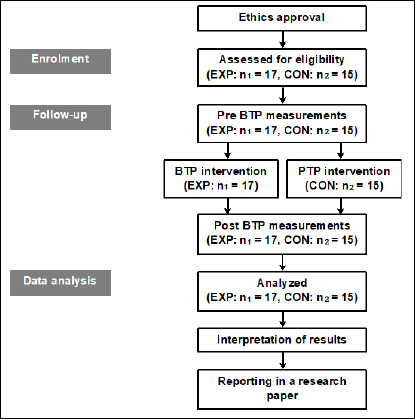
Experimental design of the present study. BTP, balance-training program; CON, control group; EXP, experimental group; PTP, placebo-training program.
In the second phase (8 weeks), the EXP group followed a balance-training program (BTP) aimed at improving balance (Supplement Table 1). The BTP started immediately after the regular training program and a total of 24 training sessions were conducted. The program was changed every two weeks (Supplement Table 1); its duration and level of difficulty were increased, by giving the participants more complex exercises and having them perform with their eyes closed (thus cancelling the advantage of visual information). For the intervention program, instruments such as bosu balls, mini trampolines, wobble boards, balance beams, agility ladders, hoops and obstacles were used. The BTP was based on Gebel et al. assumptions and the dose-response relation of balance training to balance performance in youth, with regard to the modality duration of a single training session, training frequency per week and overall training sessions (Gebel et al., 2018). At the same time, during the second phase of 8 weeks the CON group followed a placebo-training program (PTP) for time reaction of upper limbs (Supplement Table 2).
Supplement Table 1.
The 8-week balance-training program: sets of 6 balance exercises performed as circular training ×3 session per week.
| Weeks 1-2: Work/Rest: 30/30 s, Sets: 2, Rest Between Sets: 2 min |
|
| Weeks 3-4: Work/Rest: 45/45 s, Sets: 2, Rest Between Sets: 2 min |
|
| Weeks 5-6: Work/Rest: 45/45 s, Sets: 2, Rest Between Sets: 2 min |
|
| Weeks 7-8: Work/Rest: 45/45 s, Sets: 2, Rest Between Sets: 2 min |
|
Supplement Table 2.
Program for time reaction of upper limbs (full) of the control group.
| Weeks 1-2: Work/Rest: 45/45 s, Sets: 4, Rest Between Sets: 2 min |
|
| Weeks 3-4: Work/Rest: 45/45 s, Sets: 4, Rest Between Sets: 2 min |
|
| Weeks 7-8: Work/Rest: 45/45 s, Sets: 4, Rest Between Sets: 2 min |
|
In the third phase (Post condition), both groups repeated the measurements of the first phase. Participants knew only that they had to perform their best all the time and no feedback was given to them until the end of the study. Participants, coaches who deliver the BTP/PTP and assessment researchers were all unaware of the real purposes of the research (triple blind design), in an effort to reduce placebo or nocebo effects. Moreover, it was emphasized (in considerable detail) to the parents/guardians that they had to make sure the adolescent players would take no supplements with an ergogenic or synergistic effect (Havenetidis and Bourdas, 2003; Deltsidou et al., 2020; Bourdas et al., 2021a), would have to maintain their regular sleeping and resting habits, and would have to follow the balanced diet pre-described by the researchers (i.e., 15% protein, 25-30% fat, and 50-60% carbohydrates energy intake) as best they could during the entire study period.
The measurement of anthropometric characteristics and the evaluation of static and dynamic balance were carried out in a laboratory environment at sea level (mean temperature 23ºC, mean humidity 35%, barometric pressure range 1010-1025 mmHg), while the technical skill assessment tests were performed on the soccer field (of synthetic grass) where the team trained and competed (mean temperature 24ºC, mean humidity 37%, barometric pressure range 1010-1025 mmHg). Both groups did not engage in any strenuous physical activity two days prior to the Pre and Post condition measurements. The participants wore always shorts and sport shoes when performing any test. The study was conducted towards the end of the season (March-June).
Anthropometric measurements
Height, sitting height (Height Indicator Tape Ruler, Posh Rulers, Oregon, USA) and body mass (Bilance, Salus, Milano, Italy) were measured and the maturity offset was calculated as suggested [maturity offset = (-8.128741-0.2683693) + (0.0070346 × age × sitting height)] (Moore et al., 2015).
The percentage of body fat was estimated by measuring triceps and calf skinfolds using a formula for boys aged 6-17 years [%BF= 0.735 (triceps + calf) + 1.0] (Slaughter et al., 1988). Skinfold measurement was executed as suggested (Eston and Reilly, 2008) with the use of a Skinfold Calliper (Harpenden Skinfold Calliper, Baty International, West Sussex, UK). Furthermore, participants self-determined leg dominance by answering which was their preferred kicking leg.
Static balance assessment
A test proposed by Johnson & Nelson (Johnson and Nelson, 1986) was used for measuring static balance in vertical support for individuals aged 10 years and older . The participant tried to keep his balance while standing on one foot on a thin wooden surface. To execute the test, the participant placed the front 1/3 of his sole on the wooden surface. After that, he raised and bent the other leg at the knee joint, trying to maintain his position on the wooden plank for as long as possible, all the while being free to use his hands for performing balancing movements. The surface dimensions were 28 × 25 × 25 cm (length × width × height) (Johnson and Nelson, 1986). Balance timing was recorded by two examiners using a digital stopwatch (A740MX, Accusplit, Pleasanton, USA). The mean recorded time was used to evaluate the athlete’s performance.
Prior to the measurement, oral instructions and a demonstration of the test were provided by one examiner, and the participant was given time for a familiarization trial for each leg. The participant performed 3 attempts for each leg without any pause in between. The attempt was considered valid if the participant managed to keep his balance on the plank for over 3 s. If not, the attempt was repeated. The total time for completion of the 6 attempts (measured on the order of a hundredth of a second) was calculated and used as a performance indicator of the test.
Dynamic balance assessment
The dynamic balance was assessed by using the Lafayette balance device (Stability Platform 16030, Lafayette Instrument, Lafayette, USA). The device comprises a wooden platform (107 × 65 cm) supported by two very thin aluminium shafts that allow it to move in a seesaw-like way. The dimensions of the whole device are 107 × 96 × 56 cm. This platform was linked to an electronic timer that recorded the time the subject remains in the balance position (the horizontal position plus a 5° margin on either side). Initially, the platform was placed in a sloping position; the examiner used his foot to hold the side that corresponded to the subject’s dominant leg (i.e., preferred to kick a ball) in contact with the floor. The participant stepped on the platform with his dominant leg, at the center of the designated area. Then, with the examiner’s help, he placed his other foot in the corresponding area on the other side of the platform. When the subject’s feet were correctly positioned on the platform, the examiner let go of the platform and began measuring the subject’s balance time on the order of a millisecond. Three attempts of 30 s were performed, with an equidistant break between attempts. Prior to the evaluation, oral instructions and a demonstration of the procedure were provided by the examiner. The participant was also given a 3-second familiarization trial. One examiner handled the balance device and recorded time and another ensured the correct execution of the test. The participant’s score was obtained by calculating the average of the three attempts. In both static and dynamic balance tests, no feedback or any form of motivation was provided by the examiners.
Technical skills assessment
Five different technical skills (on passing, shooting, dribbling and juggling) were evaluated through a series of field tests. Participants performed a 15-minute controlled warm-up which included light jogging and dynamic stretching.
Passing test (Figure 1): Passing ability was checked using the test designed by Rösch et al. (2000), which assesses the accuracy of passing, (reliability: ICC = 0.82, r = 0.83, CV = 6.70%, validity: discriminative as elite players performed better than novice players p < 0.05) (Rösch et al., 2000). A 4-by-4-meter square was drawn at a distance of 11 meters from a small goal measuring 90 × 60 cm. The participant dribbled the ball inside the square toward the goal. On reaching the edge of the square, participant passed toward the goal. Five attempts were made for each leg with no pause in between. The player scored three points if the ball entered the goal, one point if the ball hit the goalpost or crossbar, and no point if the ball passed outside the goalposts or above the crossbar. The score of the performance was the sum of the points accrued separately with each leg (dominant and non-dominant).
Figure 1.

Passing test (Rösch et al., 2000). The participant dribbled the ball toward the goal. On reaching the edge of the shooting line, the participant passed toward the goal.
Shooting test (Figure 2): The shooting test was adequately described by Rösch et al. (2000), (reliability: ICC = 0.88 r = 0.88, CV = 7.10%) (Padrón-Cabo et al., 2019). The goal was divided into six equal segments (3 up and 3 down). The ball was placed at a distance of 16 meters from the center of the goal. The participant had to shoot the ball from that point, aiming alternately at the right and left upper segments of the goal. Each participant had 6 attempts for each foot, three for each of those two segments. The participant got three points if he succeeded in sending the ball to the correct segment, one point if the ball hit the crossbar or the goalpost in this segment, and one point if he shot into the top middle segment. He got no points if the ball missed the goal or went into any of the lower segments of the goal. The score of the performance was the sum of 6 attempts separately for each foot.
Figure 2.
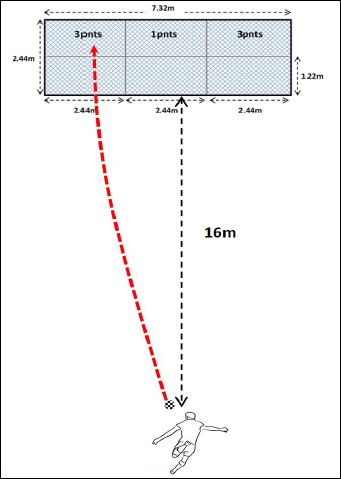
Shooting test (Rösch et al., 2000). The participant had to shoot the ball from 16 meters from the center of the goal, aiming alternately at the right and left upper segments of the goal.
Dribbling test (Figure 3): Dribble was evaluated by the test used by the Finnish Football Federation and in similar studies (Forsman et al., 2016). This test comprised 20 m running with the ball in a figure-of-eight fashion around cones placed 2-4 meters apart (reliability: r = 0.82, p < 0.00) (Forsman et al., 2016). The participant should make at least 3 contacts with the ball until it reached the last pole. At start and finish, photocells (Racetime 2, Microgate, Bolzano, Italy) were placed to record the runtime of the test, on the order of a hundredth of a second.
Figure 3.
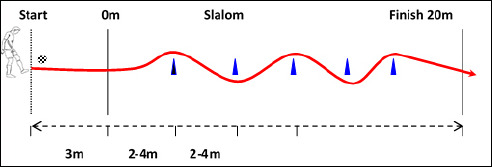
Dribbling test (Forsman et al., 2016). Twenty meters of running with the ball in a figure-of-eight fashion around cones placed 2-4 meters apart. The participant should make at least three contacts with the ball until it reaches the last pole.
Juggling tests (Figure 4): Juggling was conducted with two separate trials of increasing difficulty, as suggested by Bekris and Gioldasis (2016). The first test (Jug1) evaluated control of the ball in the air (for both legs) in a limited space (a 3-by-3-meter square) and for a limited time (30 s), while the second test (Jug2) evaluated the same skill (only for the dominant leg) as the subject moves with directional changes on a predetermined route and was described by Bekris and Gioldasis (2016)], (reliability: Jug1: r = 0.86, p < 0.01, ICC = 0.85, p < 0.00, validity: discriminative as elite players performed better than novice players p < 0.00. Jug2: r = 0.84 p < .01, ICC = 0.84 p < 0.01, validity: discriminative as elite players performed better than novice players p < 0.00) (Forsman et al., 2016).
Figure 4.
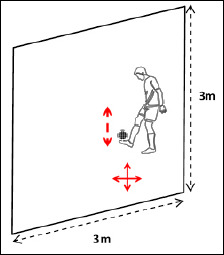
Effects of intervention (Bekris and Gioldasis, 2016). In the first test (Jug1), the participant controls the ball in the air in a limited space and for a limited time (30 s), while the second test (Jug2) evaluates the same skill as the participant moves with directional changes on a predetermined route.
Statistical analysis
For the analysis of the data, SPSS (v.23, IBM, USA) for Windows was used. Data were normally distributed, according to Shapiro-Wilks tests and Q - Q graphs of dependent variables (p > 0.05). Pearson’s (r) correlation coefficient was used to see if there was any correlation between variables and between changes in balance vs. changes in performance type variables. Α 2 by2 (groups × condition) mixed analysis of variance (ANOVA) with repeated measures on the condition factor was used to assess possible differences between groups and conditions for each variable. Partial eta squared (η2p) and their 95% confidence intervals (CI) were also calculated. Bonferroni correction method was applied for locating differences in statistical significant interactions. Probability level of less than 0.05 (p < 0.05) was considered significant for all statistical analyses.
The experimental sample size of 17 (≥ 16) was established on statistical power calculations (80%) to detect statistical significance (p < 0.05) (GraphPad StatMate Version 2.0, GraphPad Software Inc., La Jolla, CA, USA) for the primary variables based on our 0.55 pilot effect size [observed in balance trials between experimental (n1 = 8) and control groups (n2 = 6) using the same BTP and demonstrated significant changes].
Results
Anthropometric measurements
There were no differences in any of the anthropometric measurements between groups before and after the BTP. A significant correlation of anthropometric characteristics and maturation with dynamic balance was observed (r = -0.41 to -0.65; p = 0.00-0.03). On the contrary, static balance does not appear to be significantly related to any of the anthropometric measurements (r = -0.06 to 0.05; p > 0.05).
Balance
Descriptive statistics for both types of balance are presented in Table 2 for experimental group and in Table 3 for control group. There were no differences in any of the balance measurements between groups in Pre-condition.
Table 2.
Descriptive statistics of dynamic and static balance of experimental group (n = 17). Values are mean ± SD (95% Confidence Interval).
| Balance | Pre | Post |
|---|---|---|
| *Dynamic (s) | 11.37 ± 3.61 (9.51-13.22) |
14.21 ± 3.85 (12.24-16.19) |
| Static (s) | 49.63 ± 18.55 (40.10-59.17) |
68.40 ± 37.91 (48.91 – 87.90) |
*Significant differences between conditions, p < 0.05.
CON, control group; EXP, experimental group; Pre, condition prior to the balance-training program; Post, condition after the balance-training program; SD, standard deviation
Table 3.
Descriptive statistics of dynamic and static balance of control group (n = 15). Values are mean ± SD (95% Confidence Interval).
| Balance | Pre | Post |
|---|---|---|
| Dynamic (s) | 10.59 ± 2.86 (9.00-12.17) |
10.78 ± 2.39 (9.46-12.11) |
| Static (s) | 41.48 ± 16.83 (32.16-50.80) |
40.04 ± 10.42 (34.37-45.70) |
CON, control group; EXP, experimental group; Pre, condition prior to the balance-training program; Post, condition after the balance-training program; SD, standard deviation
Dynamic. The results of the 2 x 2 (groups by condition) mixed ANOVA with repeated measures on condition factor for dynamic balance showed statistical significance for groups by condition interaction (F1,30 = 8.16, p = 0.008; ηp2 = 0.21, 95% CI = 0.15-0.27), and statistical main effects for both groups (F1,30 = 3.93, p = 0.057; ηp2 = 0.12, 95% CI = 0.07-0.17) and condition (F1,30 = 10.74, p = 0.003; ηp2 = 0.26, 95% CI = 0.20-0.32). Subsequent Bonferroni pairwise comparisons for the significant inter action revealed a significant improvement for the EXP group from Pre to Post condition (p = 0.000) and a significant difference between the EXP and CON groups in the Post condition (p = 0.006).
Static. The groups by condition mixed ANOVA with repeated measures on the second factor for static balance revealed statistical significance interaction (F1,30 = 4.50, p = 0.042; ηp2 = 0.13, 95% CI = 0.08-0.18). Bonferroni pairwise comparisons indicated that the EXP group exhibited significantly better performance than the CON group in the Post condition (p = 0.007). The groups and condition main effects, as well as the rest of the pairwise comparisons, did not reach statistical significance (all p > 0.05).
Technical skills
Descriptive statistics for technical skills are presented in Table 4 for experimental group and in Table 5 for control group. There were no differences in any of the technical skills between groups in Pre-condition. No significant correlations were observed between balance (dynamic or static) and any technical skill either for EXP or for CON group pre or post BTP.
Table 4.
Technical skills of experimental group (n = 17). Values are mean ± SD (95% Confidence Interval).
| Technical Skills | Pre | Post |
|---|---|---|
| Dribbling (s) | 29.30 ± 2.12 (28.21-30.39) |
29.62 ± 2.42 (28.38-30.87) |
| Jug1 (D) (rep) | 24.88 ± 19.51 (14.85-34.91) |
29.53 ± 18.88 (19.82-39.24) |
| Jug1 (ND) (rep) | 8.76 ± 11.50 (2.85-14.68) |
7.41 ± 5.82 (4.42-10.40) |
| Jug2 (m) | 7.56 ± 5.52 (4.73-10.40) |
8.56 ± 5.57 (5.70-11.42) |
| Passing (D) (pts) | 9.00 ± 3.66 (7.12-10.88) |
§11.06 ± 2.73 (9.76-12.35) |
| Passing (ND) (pts) | 5.76 ± 2.49 (4.49-7.04) |
5.24 ± 3.03 (3.68-6.79) |
| *Shooting (D) (pts) | 3.65± 2.45 (2.39-4.91) |
§6.71 ± 3.10 (5.11-8.30) |
| Shooting (ND) (pts) | 0.82 ± 1.67 (-0.03-1.68) |
1.76 ± 2.11 (0.68-2.85) |
*Significant differences between conditions, p < 0.05.
D, dominant leg; ND, non-dominant; Pre, condition prior to the balance-training program; Post, condition after the balance-training program; pts, points; rep, repetitions; SD, standard deviation
Table 5.
Technical skills of control group (n = 15). Values are mean ± SD (95% Confidence Interval).
| Technical Skills | Pre | Post |
|---|---|---|
| Dribbling (s) | 30.30 ± 2.09 (29.14-31.45) |
30.71 ± 2.41 (29.38-32.04) |
| Jug1 (D) (rep) | 20.93 ± 14.09 (13.13-28.74) |
19.87 ± 14.10 (10.06-25.68) |
| Jug1 (ND) (rep) | 5.47 ± 4.42 (3.02-7.92) |
6.27 ± 3.58 (4.29-8.25) |
| Jug2 (m) | 7.41 ± 4.80 (4.75-10.07) |
7.33 ± 5.98 (4.02-10.64) |
| Passing (D) (pts) | 6.67 ± 3.83 (4.55-8.79) |
7.00 ± 3.68 (4.96-9.04) |
| Passing (ND) (pts) | 4.20 ± 4.07 (1.94-6.46) |
4.53 ± 2.39 (3.21-5.85) |
| Shooting (D) (pts) | 2.87 ± 3.14 (1.13-4.60) |
3.00 ± 2.62 (1.55-4.45) |
| Shooting (ND) (pts) | 1.07 ± 2.28 (-0.20-2.33) |
1.73 ± 2.34 (0.44-3.03) |
D, dominant leg; ND, non-dominant; Pre, condition prior to the balance-training program; Post, condition after the balance-training program; pts, points; rep, repetitions; SD, standard deviation
Dribbling: The results of the groups by condition mixed ANOVA with repeated measures on the second factor for dribbling did not reach statistical significance for the groups by condition interaction (F1,30 = 0.02, p = 0.889; ηp2 = 0.00, 95% CI = 0.00-0.00) and groups (F1,30 = 1.99, p = 0.17; ηp2 = 0.06, 95% CI = 0.03-0.09) and condition (F1,30 = 1.32, p = 0.260; ηp2 = 0.04, 95% CI = 0.01-0.07) main effects.
Juggling 1. For Juggling 1, the groups by condition mixed ANOVA with repeated measures on the second factor did not showed statistically significant (a) interactions for dominant (F1,30 = 3.83, p = 0.060; ηp2 = 0.11, 95% CI = 0.07-0.15) and non-dominant leg (F1,30 = 0.55, p = 0.463; ηp2 = 0.02, 95% CI = 0.00-0.04) and (b) main effects for (i) groups [(F1,30 = 1.88, p = 0.181; ηp2 = 0.060, 95% CI = 0.03-0.09), (F1,30 = 1.12, p = 0.299; ηp2 = 0.04, 95% CI = 0.01-0.07) for dominant and non-dominant leg, respectively] and (ii) condition [(F1,30 = 0.16, p = 0.691; ηp2 = 0.01, 95% CI = 0.00-0.02), (F1,30 = 0.04, p = 0.850; ηp2 = 0.00, 95% CI = 0.00-0.00) for dominant and non-dominant leg, respectively]. However, it is worth noting that despite not reaching conventional significance levels, there was a borderline groups by condition significant interaction for the dominant leg (p = 0.060), a notable improvement tendency for the EXP group, and a borderline difference between groups in the Post condition (p = 0.060) (Table 4-5).
Juggling 2. Similarly for Juggling 2, the groups by condition mixed ANOVA with repeated measures on the second factor did not showed statistical significance for interaction (F1,30 = 0.52, p = 0.478; ηp2 = 0.02, 95% CI = 0.00 – 0.04) and main effects for groups (F1,30 = 0.15, p = 0.702; ηp2 = 0.01, 95% CI = 0.00-0.02) and condition F1,30 = 0.36, p = 0.551; ηp2 = 0.01, 95% CI = 0.00-0.02).
Passing: The results of the 2 x 2 (groups by condition) mixed ANOVA with repeated measures on the condition factor for passing with the dominant leg revealed statistical significance for groups main effect (F1,30 = 10.30, p = 0.003; ηp2 = 0.26, 95% CI = 0.20-0.32) whereas they did not show statistical significance for the condition main effect (F1,30 = 2.69, p = 0.111; ηp2 = 0.08, 95% CI = 0.04-0.12) and the groups by condition interaction (F1,30 = 1.40, p = 0.246; ηp2 = 0.05, 95% CI = 0.02-0.08). Concerning the non-dominant leg, there were no statistical significances for groups by condition interaction (F1,30 = 0.32, p = 0.576; ηp2 = 0.01, 95% CI = 0.00-0.02) and groups (F1,30 = 2.20, p = 0.149; ηp2 = 0.07, 95% CI = 0.03-0.11) and condition (F1,30 = 0.02, p = 0.899; ηp2 = 0.00, 95% CI = 0.00-0.00) main effects.
Shooting: For shooting, the groups by condition mixed ANOVA with repeated measures on the second factor showed statistical significant interactions for dominant leg (F1,30 = 5.84, p = 0.022; ηp2 = 0.16, 95% CI = 0.11-0.21) and significant main effects for groups (F1,30 = 7.82, p = 0.009; ηp2 = 0.21, 95% CI = 0.15-0.27) and condition (F1,30 = 6.95, p = 0.013; ηp2 = 0.19, 95% CI = 0.13-0.25). Bonferroni pairwise comparisons for the significant interaction indicated that only the EXP group demonstrated a significant improvement in performance in the Post condition (p = 0.001). In addition, Figure 5 depicts how the intervention affected shooting accuracy with dominant leg and balance variables in both groups across time.
Figure 5.
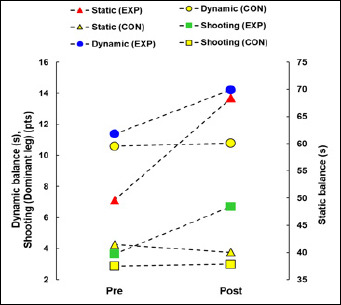
Effects of intervention (across time) on shooting accuracy and static and dynamic balance with the dominant leg in the EXP and CON groups. Data are presented as means. Abbreviations: CON, control group; EXP, experimental group; Pre, condition prior to the balance-training program; Post, condition after the balance-training program.
Discussion
The purpose of this study was to examine the effects of an 8-week BTP on dynamic and static balance, and on specific soccer technical skills in soccer players aged 12-13 years. It was found that BTP intervention shows strong interaction with both static and dynamic balance and shooting with dominant leg. There was also a significant improvement of the EXP group in shooting with dominant leg and a significant difference between EXP and CON groups in passing and shooting with dominant leg in Post condition. However, no significant correlations were observed between technical skills and dynamic or static balance in both groups.
Similar results on balance skill had also been demonstrated for soccer players aged 16, but the implementation program was performed in the same device that was used for the evaluation tests (Gioftsidou et al., 2006). This may lead to a greater improvement due to learning effect. Chew-Bullock et al. (2012) linked balance skill to accuracy in shooting. However, their research design did not include an intervention program, so they did not examine possible effects of balance improvement on shooting accuracy; furthermore, no other technical skills were studied. The majority of the participants in this study were not soccer players, and there was no restriction to the type of kicking. This means that results could be possibly affected by either an inappropriate kicking technique due to training inexperience or the choice to kick the ball with the inside of the foot, which makes kicking easier (Lees and Nolan, 1998). On the other hand, Bekris et al. (2012) investigated the effect of balance skill on technical skills of amateur soccer players to a greater extent. More specifically, they implemented a balance-training program for 10 weeks, prior to and post of which most of the basic soccer technical drills were evaluated. A significant improvement in passing and juggling after the program was demonstrated, but whether this improvement is due to balance training is under dispute, since balance skill was not measured neither before nor after the program. A most recent study showed an improvement in balance technical skills of shooting and passing after a 12-week BTP in soccer players aged 10-11 years (Cè et al., 2018). However, the BTP of this research included exercises in unstable surfaces simultaneously with the execution of soccer technical drills. This may impair improvement of technical skills, and to what extent this was a result of balance improvement or of further technical training is not totally clear. Furthermore, although researchers reported that the maturation rate of visual, somatosensory and vestibular systems is responsible for the differences in balance skill, they did not assess the subjects’ maturation level. The specific children’s age is considered crucial for the maturation of the above balance systems, as children are likely to use adult-like balance strategies around the age of 12 years (Hatzitaki et al., 2002; Peterson et al., 2006). Moreover, due to a deviation between chronological and biological age, children of the same age can be more than 3 years apart developmentally (Borms, 1986).
The present study confirmed the findings of Gioftsidou et al. (2006), which showed that an 8-week balance-training program significantly improves the young (16-year-old) soccer players’ dynamic balance and favors static balance. Some studies which had researched athletes from other sports also reported improvements in balance after a 4-to-8-week BTP (Holm et al., 2004; Rasool and George, 2007; Panwar et al., 2014; Zacharakis et al., 2020). It is worth noting that a relevant study showed an improvement in balance skills just two weeks after the start of a BTP (Rasool and George, 2007). The observed improvement in balance was mostly due to adaptations of the nervous system (development of neuromuscular coordination and increased neuromuscular control), resulting from the decreasing excitability of the H-reflex and the myotatic reflex seen in closed chain kinetic exercises (Holm et al., 2004; Gruber et al., 2007; Granacher et al., 2012), which may also explain our results.
In the Post condition, a significant difference was observed between the groups for passing with the dominant leg. However, it's worth noting that there was no significant interaction effect for passing, suggesting that the observed improvement in passing with the dominant leg in the EXP group may not be solely attributed to the BTP. These results are in accordance with Bekris et al.(20129 and Cè et al. (2018), who also found differences in passing performance after their intervention program in young soccer players (16-17 and 10-11 years old respectively). Ιn the passing test the player kicks the ball after dribbling it. This increases the contact time of the foot with the ball, which means that the player spends more time with one foot on the ground. This could also make the support leg more important for the successful and correct execution of the kinetic pattern, as there is a greater need for a stable base to passing with precision while moving. Nevertheless, no correlations were found between passing (dominant or non-dominant leg) and static or dynamic balance, either Pre or Post condition in the EXP group. This seems a little peculiar, as correlations were expected to be found, especially to dynamic balance, due to movement prior to passing, as was previously explained. Maybe the fact that the ball is kicked with the inside of the foot, which involves a bigger ball-contact surface and a reduced foot velocity (Lees et al., 2010), makes kicking easier and demands less precision when the foot is in contact with the ball in order for passing to be successful.
As for shooting, our results showed no differences in the non-dominant leg and a significant improvement using the dominant leg after the BTP intervention in the EXP group. Similar results for shooting accuracy were demonstrated after a BTP in 16-17- and 10-11-year-old soccer players (Bekris et al., 2012; Cè et al., 2018) Improvement of shooting accuracy through better balance could be achieved by reducing variability during movement (Teixeira et al., 2011). The support leg in shooting stabilizes the body while the swinging leg kicks, so it plays an important role in shooting performance (Lees et al., 2010). However, we did not found any correlation between shooting and balance. On the contrary, Chew-Bullock et al. (2012) observed a significant correlation between balance in the non-dominant leg and shooting accuracy but not vice versa in adults (20-38 years old), which proves the important role of the support leg’s stability in the successful execution of shooting. Soccer players seem to demonstrate better unilateral balance performance in favor of the non-dominant leg (Bigoni et al., 2017; Paillard and Noé, 2020) as a result of the greater use of the dominant leg to execute most soccer technical drills. The weaker balance performance of the dominant leg probably leads to a less stable support base, influencing the accuracy of shooting with the non-dominant leg. In addition, the worst motor control of the non-dominant leg as expressed by reduced technical ability may be a more important factor than balance in performing technical skills that require precision. Thus, when there is good motor control and a proper execution of the kinetic pattern, as it usually happens with the dominant leg, improving balance can lead to improved shooting accuracy.
A recent meta-analysis showed moderate-to-large effects on slalom dribbling after multimodal injury prevention programs including balance tasks (Faude et al., 2017). Most of the included studies were conducted on 17-year-old subjects, while all intervention programs were not exclusively balance programs, but also included exercises for strength, power, core stability, flexibility, etc. In the present study no improvement was noted in dribbling after the intervention of BTP. Likewise, an earlier study found no improvement in dribbling in 16-17-year-old soccer players (Bekris et al., 2012). It should be mentioned, however, that the technique of dribbling with the ball was assessed based on time after performing pre-defined routes, so speed and agility may play a more important role than balance in this specific test. Perhaps a test which would better assess the qualitative performance of the skill rather than the speed of execution would differentiate the results and demonstrate the importance of balance to this skill’s performance.
In the Jug1 test with the dominant leg, there was a notable improvement tendency in the EXP group, and a borderline difference between groups in the Post condition (p = 0.06) was observed, along with a trend towards an interaction effect between condition and group (p = 0.06). However, it is important to interpret these findings cautiously due to the borderline significance. Conversely, no improvement or significant difference between the EXP and CON groups was observed with the non-dominant leg. The constant shift of the center of gravity and the constant balancing effort on one leg, combined with the effort to control and keep the ball in the air, underline the importance of dynamic balance for this skill. These results show that juggling the ball in the air is a technical skill in which neuromuscular coordination may play a predominant role (Rösch et al., 2000). However, as mentioned above, it seems that improving balance cannot lead to an improvement of technical skills when there is reduced technical ability and motor control, as it usually happens with the non-dominant leg.
Concerning the Jug2 test, which involved juggling the ball in the air while performing a particular route, no differences were observed. In contrast, a previous study has shown a significant improvement in juggling tests of controlling a ball in the air after balance training (Bekris et al., 2012). Subjects in the aforementioned study were older than ours (16-17 years old), which means that they were on a more advanced level of technical ability and probably had greater training experience. Keeping the ball in the air using only the tarsus while moving at the same time is a technical skill of increased difficulty for pre-adolescent players; thus, we assume that balance is probably not the primary feature required for this skill at such an early age.
Strength, limitations, and suggestions for future research
This study is subject to certain limitations that should be acknowledged. The participants played all for the same team, which prevents generalization of the results. The very specific age group and the fact that only boys participated in the study are also limiting factors. The present study explored the impact of an 8-week balance-training program on technical skills. Nevertheless, the adolescent participants are at a training stage. They are still developing and stabilizing basic sport-specific skills and may have not yet reached perfection in the corresponding kinetic standards (Bailey et al., 2010), so factors such as balance may have a different effect on them than on older players. Participants also lack the experience of older players, which undoubtedly affects the young players’ performance of technical skills. For these reasons, it is proposed to devise more elaborate programs for balance improvement, combined with ball exercises, as well as to conduct further research with different age groups. Likewise, it would be useful for future research to take into consideration the importance of factors such as the athletes’ sex, playing position, sport modalities and different competing level (Bekris et al., 2022; Souglis et al., 2023). The participants in our study were considered to be in a crucial age for the maturation of balance systems and balancing strategies, as previously mentioned (Hatzitaki et al., 2002; Peterson et al., 2006). This indicates that maturation could significantly affect their balance skills. In order to reduce the probability of biased results due to differences in maturation among the young participants, we calculated the maturation effect and found no significant differences before or after the intervention program. As a result, the players’ maturation level and physical characteristics are unlikely to cause any difference or change in balance or technique.
To our knowledge, this study represents the first investigation to assess the impact of a dedicated balance-training intervention on adolescent soccer players, specifically targeting individuals between the ages of 12 and 13, using a sound experimental design. In addition, while the positive effects of balance training on adolescent soccer players may be expected, our study provides empirical evidence to support these expectations. The practical integration of balance exercises into regular training schedules can be achieved by carefully designing exercises that align with players' preferences and by progressively increasing their complexity to maintain engagement and ensure skill transfer to game situations. Coach education and awareness are also essential components of successful implementation. However, future researches, which would also explore the players’ technical and tactical characteristics in different BTPs, should provide important information to coaches and could prove to be valuable tools in building effective soccer training programs.
Conclusion
Our study demonstrates that balance skills and shooting accuracy with the dominant leg can be enhanced in soccer players aged 12-13 years through the implementation of a BTP. Additionally, our results suggest a potential association between the improvement in balance and shooting accuracy, although further research, including correlation analysis, is needed to establish the strength and nature of this relationship. It also seems that the introduction of a specialized balance-training program into groups of adolescence soccer players in order to maximize the beneficial effects of their training session on technical skills is a promising practice.
Acknowledgements
The authors gratefully acknowledge the valuable contribution of all the participants, parents/guardians and the soccer club to this study. This research did not receive any specific grant from funding agencies in the public, commercial, or not-for-profit sectors. The authors declare that they have no known competing financial interests or personal relationships that could have appeared to influence the work reported in this article. The present study complies with the current laws of the country in which it was performed. The datasets generated and analyzed during the current study are not publicly available but are available from the corresponding author, who was an organizer of the study.
Biographies

Ioannis MITROUSIS
Employment
Department of Sports Coaching and Physical Education, Metropolitan College, Piraeus, Greece
Degree
PhD(c) in Sports Coaching, MSc in Sports Coaching, B.Sc. in Sports Science and Physical Education
Research interests
Football Coaching, Performance Analysis in Football
E-mail: gmitrousis@phed.uoa.gr

Dimitrios I. BOURDAS
Employment
Section of Sport Medicine & Biology of Exercise, School of Physical Education and Sports Science, National and Kapodistrian University of Athens, Greece
Degree
PhD, MSc, P.G.Dipl., B.Sc. (Hons)
Research interests
Sports and Exercise, Nutrition and Dietetics, Respiratory Medicine, Marine Biology, Physiology, Human Biology, Extreme Environments
E-mail: dbourdas@phed.uoa.gr

Stylianos KOUNALAKIS
Employment
Department of Physical and Cultural Education Military Army Academy, Greece
Degree
PhD
Research interests
Regulation of the cardiovascular, respiratory and thermoregulatory system during exercise in normal and extreme conditions, such as hypoxia and deconditioning.
E-mail: skounal@phed.uoa.gr

Evangelos BEKRIS
Employment
School of Physical Education and Sports Science, National and Kapodistrian University of Athens, Greece
Degree
PhD
Research interests
Football Training, Evaluation of football players, Biochemical and hematological changes in football
E-mail: vagbekris@phed.uoa.gr

Michail MITROTASIOS
Employment
School of Physical Education and Sports Science, National and Kapodistrian University of Athens, Greece
Degree
PhD
Research interests
Football training
E-mail: micmit@phed.uoa,gr

Nikolaos KOSTOPOULOS
Employment
School of Physical Education and Sports Science, National and Kapodistrian University of Athens, Greece
Degree
PhD
Research interests
Performance and coaching in basketball, Basketball Administration, Sport Medicine and Science Basketball
E-mail: nikkosto@phed.uoa.gr

Ioannis KTISTAKIS
Employment
School of Physical Education and Sports Science, National and Kapodistrian University of Athens, Greece
Degree
PhD(c)
Research interests
Performance and coaching in basketball
E-mail: ktistakisy@phed.uoa.gr

Emmanouil ZACHARAKIS
Employment
School of Physical Education and Sports Science, National and Kapodistrian University of Athens, Greece
Degree
PhD
Research interests
Performance and coaching in basketball, applied exercise physiology and biomechanics in team sports, Adapted physical activity
E-mail: emzch@phed.uoa.gr
References
- Bailey R., Collins D., Ford P., Macnamara Á., Toms M., Pearce G. (2010) Participant Developmentin Sport: An Academic Review. 1st edition. (ed A Masha). Sports Coach; UK. [Google Scholar]
- Bangsbo J. (1994) The physiology of soccer with special reference to intense intermittent exercise. Acta physiologica Scandinavica 619, 1-155. [PubMed] [Google Scholar]
- Bekris E., Bourdas D.I., Mylonis E., Ispirlidis I., Zacharakis E.D., Katis A. (2022) Effect of 3 vs. 3 Soccer Small-Sided Game on Various Performance, Inflammatory, Muscle Damage and Hormonal Indicators in Semi-Professional Players. Sports 10, 1-15. https://doi.org/10.3390/sports10070102 10.3390/sports10070102 [DOI] [PMC free article] [PubMed] [Google Scholar]
- Bekris E., Gioldasis A. (2016) Juggling Test Battery. The Swedish Journal of Scientific Research 3, 2001–9211. [Google Scholar]
- Bekris E., Kahrimanis G., Anagnostakos K., Gissis I., Papadopoulos C., Sotiropoulos A. (2012) Proprioception and balance training can improve amateur soccer players’ technical skills. Journal of Physical Education and Sport 12, 81-89. [Google Scholar]
- Bigoni M., Turati M., Gandolla M., Augusti C.A., Pedrocchi A., La Torre A., Piatti M., Gaddi D. (2017) Balance in young male soccer players: dominant versus non-dominant leg. Sport Sciences for Health 13, 253-258. https://doi.org/10.1007/s11332-016-0319-4 10.1007/s11332-016-0319-4 [DOI] [Google Scholar]
- Borms J. (1986) The child and exercise: An overview. Journal of Sports Sciences 4, 3-20. https://doi.org/10.1080/02640418608732093 10.1080/02640418608732093 [DOI] [PubMed] [Google Scholar]
- Bourdas D.I., Souglis A., Zacharakis E.D., Geladas N.D., Travlos A.K. (2021a) Meta-Analysis of Carbohydrate Solution Intake during Prolonged Exercise in Adults: From the Last 45+ Years’ Perspective. Nutrients 13, 4223. https://doi.org/10.3390/nu13124223 10.3390/nu13124223 [DOI] [PMC free article] [PubMed] [Google Scholar]
- Bourdas D.I., Zacharakis E.D., Travlos A.K., Souglis A., Georgali T.I., Gofas D.C., Ktistakis I.E., Deltsidour A. (2021b) Impact of lockdown on smoking and sleeping in the early COVID-19 presence: datasets of Greek Adults sample. Data in Brief 39, 107480. https://doi.org/10.1016/j.dib.2021.107480 10.1016/j.dib.2021.107480 [DOI] [PMC free article] [PubMed] [Google Scholar]
- Bourdas D.I., Zacharakis E.D. (2020a) Impact of COVID-19 Lockdown on Physical Activity in a Sample of Greek Adults. Sports 8, 139. https://doi.org/10.3390/sports8100139 10.3390/sports8100139 [DOI] [PMC free article] [PubMed] [Google Scholar]
- Bourdas D.I., Zacharakis E.D. (2020b) Evolution of changes in physical activity over lockdown time: Physical activity datasets of four independent adult sample groups corresponding to each of the last four of the six COVID-19 lockdown weeks in Greece. Data in Brief 32, 106301. https://doi.org/10.1016/j.dib.2020.106301 10.1016/j.dib.2020.106301 [DOI] [PMC free article] [PubMed] [Google Scholar]
- Bressel E., Yonker J., Kras J., Heath E. (2007) Comparison of Static and Dynamic Balance in Female Collegiate Soccer, Basketball, and Gymnastics Athletes. Journal of Athletic Training 42, 42-46. [PMC free article] [PubMed] [Google Scholar]
- Butler R.J., Southers C., Gorman P.P., Kiesel K.B., Plisky P.J. (2012) Differences in soccer players’ dynamic balance across levels of competition. Journal of Athletic Training 47, 616-620. https://doi.org/10.4085/1062-6050-47.5.14 10.4085/1062-6050-47.5.14 [DOI] [PMC free article] [PubMed] [Google Scholar]
- Cè E., Longo S., Paleari E., Riboli A., Limonta E., Rampichini S., Coratella G., Esposito F. (2018) Evidence of balance training-induced improvement in soccer-specific skills in U11 soccer players. Scandinavian Journal of Medicine and Science in Sports 28, 2443-2456. https://doi.org/10.1111/sms.13240 10.1111/sms.13240 [DOI] [PubMed] [Google Scholar]
- Chew-Bullock T.S.Y., Anderson D.I., Hamel K.A., Gorelick M.L., Wallace S.A., Sidaway B. (2012) Kicking performance in relation to balance ability over the support leg. Human Movement Science 31, 1615-1623. https://doi.org/10.1016/j.humov.2012.07.001 10.1016/j.humov.2012.07.001 [DOI] [PubMed] [Google Scholar]
- Deltsidou A., Zarikas V., Mastrogiannis D., Kapreli E., Bourdas D., Raftopoulos V., Noula M., Lykeridou K. (2020) Data on advanced glycation end-products concentrations and haemodynamic parameters following caffeine and nicotine consumption in nursing students. Data in Brief 32, 106063., https://doi.org/10.1016/j.dib.2020.106063 10.1016/j.dib.2020.106063 [DOI] [PMC free article] [PubMed] [Google Scholar]
- Eston R., Reilly T. (2008) Kinanthropometry And Exercise Physiology Laboratory Manual. 3rd edition. (eds Eston R, Reilly T.). Milton Park, Abingdon, Oxon, OX14 4RN: Routledge. https://doi.org/10.4324/9780203868744 10.4324/9780203868744 [DOI] [Google Scholar]
- Faude O., Rössler R., Petushek E.J., Roth R., Zahner L., Donath L. (2017) Neuromuscular adaptations to multimodal injury prevention programs in youth sports: A systematic review with meta-analysis of randomized controlled trials. Frontiers in Physiology 8, 1-15. https://doi.org/10.3389/fphys.2017.00791 10.3389/fphys.2017.00791 [DOI] [PMC free article] [PubMed] [Google Scholar]
- Forsman H., Gråstén A., Blomqvist M., Davids K., Liukkonen J., Konttinen N. (2016) Development of perceived competence, tactical skills, motivation, technical skills, and speed and agility in young soccer players. Journal of Sports Sciences 34, 1311-1318. https://doi.org/10.1080/02640414.2015.1127401 10.1080/02640414.2015.1127401 [DOI] [PubMed] [Google Scholar]
- Gebel A., Lesinski M., Behm D.G., Granacher U. (2018) Effects and Dose–Response Relationship of Balance Training on Balance Performance in Youth: A Systematic Review and Meta-Analysis. Sports Medicine 48, 2067-2089. https://doi.org/10.1007/s40279-018-0926-0 10.1007/s40279-018-0926-0 [DOI] [PubMed] [Google Scholar]
- Gerbino P.G., Griffin E.D., Zurakowski D. (2007) Comparison of standing balance between female collegiate dancers and soccer players. Gait and Posture 26, 501-507. https://doi.org/10.1016/j.gaitpost.2006.11.205 10.1016/j.gaitpost.2006.11.205 [DOI] [PubMed] [Google Scholar]
- Gioftsidou A., Malliou P., Pafis G., Beneka A., Godolias G., Maganaris C.N. (2006) The effects of soccer training and timing of balance training on balance ability. European Journal of Applied Physiology 96, 659-664. https://doi.org/10.1007/s00421-005-0123-3 10.1007/s00421-005-0123-3 [DOI] [PubMed] [Google Scholar]
- Granacher U., Gollhofer A., Kriemler S. (2012) Effects of Balance Training on Postural Sway, Leg Extensor Strength, and Jumping Height in Adolescents. Research Quarterly for Exercise and Sport 81, 245-251. https://doi.org/10.1080/02701367.2010.10599672 10.1080/02701367.2010.10599672 [DOI] [PubMed] [Google Scholar]
- Gruber M., Taube W., Gollhofer A., Beck S., Amtage F., Schubert M. (2007) Training-specific adaptations of H- and stretch reflexes in human soleus muscle. Journal of Motor Behavior 39, 68-78. https://doi.org/10.3200/JMBR.39.1.68-78 10.3200/JMBR.39.1.68-78 [DOI] [PubMed] [Google Scholar]
- Hatzitaki V., Zlsi V., Kollias I., Kioumourtzoglou E. (2002) Perceptual-motor contributions to static and dynamic balance control in children. Journal of Motor Behavior 34, 161-170. https://doi.org/10.1080/00222890209601938 10.1080/00222890209601938 [DOI] [PubMed] [Google Scholar]
- Havenetidis K., Bourdas D. (2003) Creatine supplementation: Effects on urinary excretion and anaerobic performance. Journal of Sports Medicine and Physical Fitness 43, 347-355. [PubMed] [Google Scholar]
- Holm I., Fosdahl M.A., Friis A., Risberg M.A., Myklebust G., Steen H. (2004) Effect of Neuromuscular Training on Proprioception, Balance, Muscle Strength, and Lower Limb Function in Female Team Handball Players. Clinical Journal of Sport Medicine 14, 88-94. https://doi.org/10.1097/00042752-200403000-00006 10.1097/00042752-200403000-00006 [DOI] [PubMed] [Google Scholar]
- Hrysomallis C. (2011) Balance ability and athletic performance. Sports Medicine 41, 221-232. https://doi.org/10.2165/11538560-000000000-00000 10.2165/11538560-000000000-00000 [DOI] [PubMed] [Google Scholar]
- Johnson B.L., Nelson J.K. (1986) Practical Measurements for Evaluation in Physical Education. 4th edition. New York, NY, USA: Macmillan. [Google Scholar]
- Kiers H., Van Dieën J., Dekkers H., Wittink H., Vanhees L. (2013) A systematic review of the relationship between physical activities in sports or daily life and postural sway in upright stance. Sports Medicine 43, 1171-1189. https://doi.org/10.1007/s40279-013-0082-5 10.1007/s40279-013-0082-5 [DOI] [PubMed] [Google Scholar]
- Lees A., Asai T., Andersen T.B., Nunome H., Sterzing T. (2010) The biomechanics of kicking in soccer: A review. Journal of Sports Sciences 28, 805-817. https://doi.org/10.1080/02640414.2010.481305 10.1080/02640414.2010.481305 [DOI] [PubMed] [Google Scholar]
- Lees A., Nolan L. (1998) The biomechanics of soccer : A review. Journal of Sports Sciences 16, 211-234. https://doi.org/10.1080/026404198366740 10.1080/026404198366740 [DOI] [PubMed] [Google Scholar]
- Mickle K.J., Munro B.J., Steele J.R. (2011) Gender and age affect balance performance in primary school-aged children. Journal of Science and Medicine in Sport 14, 243-248. https://doi.org/10.1016/j.jsams.2010.11.002 10.1016/j.jsams.2010.11.002 [DOI] [PubMed] [Google Scholar]
- Moore S.A., McKay H.A., Macdonald H., Nettlefold L., Baxter-Jones A.D.G., Cameron N., Brasher P.M.A. (2015) Enhancing a somatic maturity prediction model. Medicine and Science in Sports and Exercise 47, 1755-1764. https://doi.org/10.1249/MSS.0000000000000588 10.1249/MSS.0000000000000588 [DOI] [PubMed] [Google Scholar]
- Padrón-Cabo A., Rey E., Pérez-Ferreirós A., Kalén A. (2019) Test–Retest Reliability of Skill Tests in the F-MARC Battery for Youth Soccer Players. Perceptual and Motor Skills 126, 1006-1023. https://doi.org/10.1177/0031512519866038 10.1177/0031512519866038 [DOI] [PubMed] [Google Scholar]
- Paillard T., Noé F. (2020) Does monopedal postural balance differ between the dominant leg and the non-dominant leg? A review. Human Movement Science 74, 102686. https://doi.org/10.1016/j.humov.2020.102686 10.1016/j.humov.2020.102686 [DOI] [PubMed] [Google Scholar]
- Paillard T., Noé F., Rivière T., Marion V., Montoya R., Dupui P. (2006) Postural performance and strategy in the unipedal stance of soccer players at different levels of competition. Journal of Athletic Training 41, 172-176. [PMC free article] [PubMed] [Google Scholar]
- Panwar N., Kadyan G., Gupta A., Narwa R. (2014) Effect Of Wobble Board Balance Training Program On Static Balance, Dynamic Balance &Amp; Triple Hop Distance In Male Collegiate Basketball Athlete. International Journal of Physiotherapy and Research 2, 657-662. [Google Scholar]
- Peterson M.L., Christou E., Rosengren K.S. (2006) Children achieve adult-like sensory integration during stance at 12-years-old. Gait and Posture 23, 455-463. https://doi.org/10.1016/j.gaitpost.2005.05.003 10.1016/j.gaitpost.2005.05.003 [DOI] [PubMed] [Google Scholar]
- Rasool J., George K. (2007) The impact of single-leg dynamic balance training on dynamic stability. Physical Therapy in Sport 8, 177-184. https://doi.org/10.1016/j.ptsp.2007.06.001 10.1016/j.ptsp.2007.06.001 [DOI] [Google Scholar]
- Ricotti L. (2011) Static and dynamic balance in young athletes. Journal of Human Sport and Exercise 6, 616-628. https://doi.org/10.4100/jhse.2011.64.05 10.4100/jhse.2011.64.05 [DOI] [Google Scholar]
- Ricotti L., Rigosa J., Niosi A., Menciassi A. (2013) Analysis of Balance, Rapidity, Force and Reaction Times of Soccer Players at Different Levels of Competition. Plos One 8, 1-21. https://doi.org/10.1371/journal.pone.0077264 10.1371/journal.pone.0077264 [DOI] [PMC free article] [PubMed] [Google Scholar]
- Roncesvalles M.N.C., Woollacott M.H., Jensen J.L. (2001) Development of lower extremity kinetics for balance control in infants and young children. Journal of Motor Behavior 33, 180-192. https://doi.org/10.1080/00222890109603149 10.1080/00222890109603149 [DOI] [PubMed] [Google Scholar]
- Rösch D., Hodgson R., Peterson T.L., Graf-Baumann T., Junge A., Chomiak J., Dvorak J. (2000) Assessment and Evaluation of Football Performance. American Journal of Sports Medicine 28, 29-39. https://doi.org/10.1177/28.suppl_5.s-29 10.1177/28.suppl_5.s-29 [DOI] [PubMed] [Google Scholar]
- Slaughter M.H., Lohman T.G., Boileau R.A., Horswill C.A., Stillman R.J., Van Loan M.D., Bemben D.A. (1988) Skinfold equations for estimations of body fatness in children and youth. Human Biology 60, 709-723. [PubMed] [Google Scholar]
- Souglis A., Bourdas D.I., Gioldasis A., Ispirlidis I., Philippou A., Zacharakis E., Apostolidis A., Efthymioou G., Travlos A.K. (2023) Time Course of Performance Indexes, Oxidative Stress, Inflammation, and Muscle Damage Markers after a Female Futsal Match. Sports 11, 127. https://doi.org/10.3390/sports11070127 10.3390/sports11070127 [DOI] [PMC free article] [PubMed] [Google Scholar]
- Souglis A.G., Travlos A.K., Andronikos G. (2022) The effect of proprioceptive training on technical soccer skills in female soccer. International Journal of Sports Science and Coaching 18, 748-760. https://doi.org/10.1177/17479541221097857 10.1177/17479541221097857 [DOI] [Google Scholar]
- Teixeira L.A., de Oliveira D.L., Romano R.G., Correa S.C. (2011) Leg preference and interlateral asymmetry of balance stability in soccer players. Research Quarterly for Exercise and Sport 82, 21-27. https://doi.org/10.1080/02701367.2011.10599718 10.1080/02701367.2011.10599718 [DOI] [PubMed] [Google Scholar]
- Warburton D., Jamnik V., Bredin S., Gledhill N. (2018) The 2018 Physical Activity Readiness Questionnaire for Everyone (PAR-Q+) and electronic Physical Activity Readiness Medical Examination (ePARmed-X+). Health & Fitness Journal of Canada 11, 31-34. [Google Scholar]
- World Health Organization, (2016) Health Behaviour in School-aged Children Study: Physical Activity in Adolescents Key Facts and Figures. World Health Organization, 2. [Google Scholar]
- World Medical Association, (2013) Declaration of Helsinki, Ethical Principles for Scientific Requirements and Research Protocols. Bulletin of the World Health Organization; 79, 373. [PMC free article] [PubMed] [Google Scholar]
- Zacharakis E.D., Bourdas D.I., Kotsifa M.I., Bekris E.M., Velentza E.T., Kostopoulos N.I. (2020) Effect of balance and proprioceptive training on balancing and technical skills in 13-14-year-old youth basketball players. Journal of Physical Education and Sport 20, 2487-2500. [Google Scholar]
- Zacharakis E., Souglis A., Bourdas D., Gioldasis A., Apostolidis N., Kostopoulos N. (2021) The relationship between physical and technical performance characteristics of young soccer and basketball players: A comparison between two sports. Gazzetta Medica Italiana Archivio per le Scienze Mediche 180, 653-664. https://doi.org/10.23736/S0393-3660.20.04315-6 10.23736/S0393-3660.20.04315-6 [DOI] [Google Scholar]


